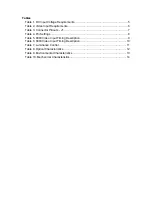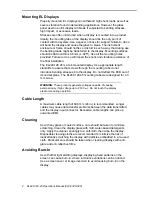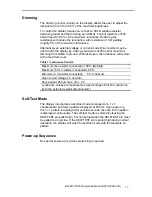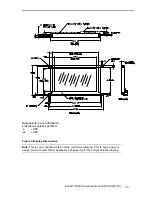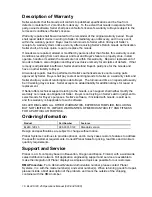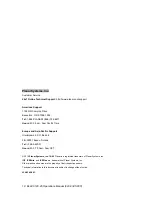
EL240.128.45 Operations Manual (020-0345-00C)
4
Mounting EL Displays
Properly mounted, EL displays can withstand high shock loads as well as
severe vibration found in demanding applications. However the glass
panel used in an EL display will break if subjected to bending stresses,
high impact, or excessive loads.
Stresses are often introduced when a display is mounted into a product.
Ideally, the mounting tabs of the display should be the only point of
contact with the system. Use a spacer or boss for support; failure to do so
will bend the display and cause the glass to break. The instrument
enclosure or frame should not flex or distort in such a way that during use
the bending loads might be transferred to the display. Mounting surfaces
should be flat to within ±0.6 mm (±.025"). Use all the mounting holes
provided. Failure to do so will impair the shock and vibration resistance of
the final installation.
The EL240.128.45 is a tab mounted display. Use appropriate length
standoffs to assure that screws through the mounting tabs do not
introduce bending stresses into the display. Do not deflect the ECB out of
its normal plane. The EL240.128.45 mounting tabs were designed for a 3
mm screw.
WARNING:
These products generate voltages capable of causing
personal injury (high voltage up to 230 V
ac
). Do not touch the display
electronics during operation.
Cable Length
A maximum cable length of 600 mm (24 in.) is recommended. Longer
cables may cause data transfer problems between the data transmitted
and the display input connector. Excessive cable lengths can pick up
unwanted EMI.
Cleaning
As with any glass or coated surface, care should be taken to minimize
scratching. Clean the display glass with mild, water-based detergents
only. Apply the cleaner sparingly to a soft cloth, then wipe the display.
Disposable cleaning cloths are recommended to minimize the risk of
inadvertently scratching the display with particles embedded in a re-used
cloth. Particular care should be taken when cleaning displays with anti-
glare and anti-reflective films.
Avoiding Burn-In
As with other light emitting displays, displaying fixed patterns on the
screen can cause burn-in, where luminance variations can be noticed.
Use a screen saver or image inversion to avoid causing burn-in on the
display.




